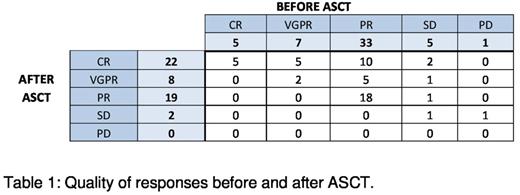Abstract
Introduction
Renal impairment occurs in 20-30% of newly diagnosed multiple myeloma patients, requiring dialysis for up to 10% of patients.Recent results ofan IFM (Intergroupe Francophone du Myélome) study confirm the effectiveness of high dose melphalan followed by Autologous Hematopoietic Stem Cell Transplantation (ASCT) as first line therapy in multiple myeloma patients. Most centers exclude renal failure patients due to concerns of toxity, because data are limited for safety and toxicity to consider. This current retrospective study observes toxicity and outcome in 55 multiple myeloma patients with severe renal impairment, undergoing high dose melphalan and ASCT, in the age of bortezomib.
Methods
Using the PROMISE database, 55 multiple myeloma patients French SFGM-TC centers were included from January 2002 to November 2012. Characteristics of the patients presenting with creatinine clearance less than 30ml/min at time of ASCT were included.
Results
Median age was 61 (40-75) years old. Thirty-nine (71%) presented free light chain myeloma. Twenty-three (42%) patients were on dialysis at the time of ASCT and during hospitalization. Thirty-one (56%) patients received bortezomib as induction therapy. Melphalan dose ranged from 75mg/m² to 200mg/m². Thirty (55%) patients were treated with a dose of 140mg/m². Median delay between diagnosis and ASCT was 5.3 months.
Among 50 patients evaluated for toxicity, respectively febrile neutropenia and mucositis occurred in 92% and 90% of patients. Half of the mucositiscases were grade 3-4. The median number of days before neutrophil and platelet recovery was respectively 12 days (10 - 34) and 16 days (7 - 331). Two patients experienced cardiac toxicity (grade 1-2), and 4 patients neurologic toxicity (grade 3 for one patient).
Among 51 patients evaluated for response, 12 patients (24%) were at least in Very Good Partial Response (VGPR) before ASCT, including 5 in Complete Response (CR). All of them were treated with bortezomib as induction therapy.
After ASCT, 30 patients (58.8%) reached at least VGPR (22 CR and 8 VGPR). Among 30 patients in VGPR or more post ASCT, 22 (73%) were treated with bortezomib before ASCT.
Table 1 shows the responses.
Fourteen (26%) received two ASCT. One patient died from toxicity (cerebral bleeding during second ASCT). There is no argument for dramatic response improvement with this procedure in comparison to single ASCT.
After a median follow-up of 55 months, median progression free survival (PFS) was 55 months, and median overall survival (OS) was 95 months. In multivariate analysis, dose of melphalan at 140mg/m² was significantly correlated with a better PFS (p=0.006), compared to 100mg/m² (or less) and to 200mg/m².
During follow-up 29 patients (54%) relapsed and 25 died. The main causes of death were relapse and disease progression (72%). There were only 3 cases of treatment related mortality (TRM). At day 100, the cumulative incidence of TRM was 6%.
Among 23 dialysis patients, 6 patients (26%) became dialysis independent, but not during ASCT. Thirteen (56%) were still alive at last follow-up, and 8 (34%) experienced relapse. Median PFS for this subgroup of patients was 73 months.
Conclusion
With an acceptable TRM, without major toxicities, high dose melphalan (140mg/m²) following by ASCT appears to be a real benefit for multiple myeloma patients with severe renal failure. This includes patients on dialysis. Response is dramatically improved by this procedure, with median PFS similar to that of patients with normal renal function. Finally, adjunction of bortezomib as induction therapy also improves the efficacy of ASCT.
Augeul-Meunier:gilead: Consultancy; janssen: Consultancy. Karlin:amgen: Consultancy, Honoraria; janssen-cilag: Consultancy, Honoraria; celgene: Consultancy, Honoraria; Bristol: Consultancy; takeda: Consultancy. Benboubker:Amgen: Honoraria, Membership on an entity's Board of Directors or advisory committees; Takeda: Honoraria, Membership on an entity's Board of Directors or advisory committees; Janssen: Honoraria, Membership on an entity's Board of Directors or advisory committees; Celgene: Honoraria, Membership on an entity's Board of Directors or advisory committees. Avet-Loiseau:sanofi: Consultancy; amgen: Consultancy; janssen: Consultancy; celgene: Consultancy.
Author notes
Asterisk with author names denotes non-ASH members.


This feature is available to Subscribers Only
Sign In or Create an Account Close Modal